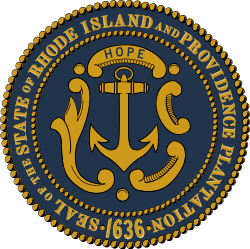Robert Coles (settler)
| Robert Coles | |
|---|---|
| Born | c. 1600 |
| Died |
1655 Warwick, Providence Plantations |
| Residence |
|
| Occupation | Farmer, miller |
| Known for |
|
| Spouse(s) |
|
| Children | 7 |
Robert Coles (c. 1600–1655) was a 17th-century New England colonist who arrived on the Winthrop Fleet. He is best known for his scarlet-letter punishment in Massachusetts Bay Colony and his role in establishing the Providence Plantations, now Rhode Island, where he helped frame a new government.
In Massachusetts Bay, Coles was a first settler of Roxbury and Agawam, now Ipswich, and an early settler of Salem. After repeated fines for drunkenness he was forced to wear a red letter "D" as a badge of shame. He left Massachusetts Bay to join Roger Williams at Providence where he was one of the settlement's 13 original proprietors and a founding member of the First Baptist Church in America. Coles co-authored the Plantation Agreement at Providence of 1640, which established a secular, representative democracy. In the Providence Plantations he was a first settler of Pawtuxet and an early settler of Shawomet, now the Rhode Island towns of Cranston and Warwick.
Massachusetts Bay Colony (1630–1637)
Arrival and settlements
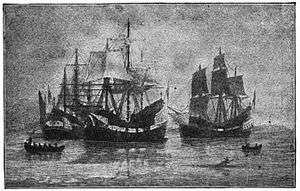
Robert Coles arrived in New England in the summer of 1630 as a passenger in the Winthrop Fleet. In 1630, he petitioned the Massachusetts Bay Colony's General Court in Boston to become a freeman and in 1631 he took the oath.[1][2]
In 1630, Coles was among the first settlers of the town of Roxbury and in 1631 he was a founding member of the First Church of Roxbury, which was then Non-separating Congregationalist.[3][4][5] In 1632, he was one of two townsmen elected to represent Roxbury in the General Court.[6][7] In 1633, Coles was in the first company, led by John Winthrop the Younger, that went to Agawam where he was granted a large home lot on the Ipswich River at present-day East and Cogswell Streets and a 200-acre tract on the neck of land north of town.[8][9][10] In 1635, he moved to Salem where he received a home lot in town and 300 acres south of Felton Hill.[11][10][2]
The scarlet letter
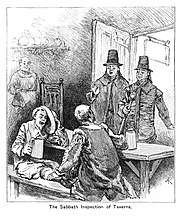
In 1631, Robert Coles was fined five marks (about £3) for drunkenness with Edward Gibbons and Mr. Shepheard aboard the Friendship and with Samuel Maverick at Winnissimet, now Chelsea.[12] The Friendship was carrying two hogsheads (more than 120 gallons) of flavored mead called metheglin.[13] Gibbons, Coles's drinking companion, was "one of the Merry Mount Society who chose rather to Dance about a May pole...than to hear a good Sermon...."[14] Maverick was "a man of loving and courteous behavior, very ready to entertain strangers," but his wealth and Episcopalianism put him at odds with the Puritans.[15]
In 1632, Coles was fined £1 for drunkenness at Charlestown. He was required to appear before the General Court and the Court of Assistants to publicly confess.[16]
In 1633, John Shatswell and Robert Coles were charged with drunkenness at Agawam. John Shatswell was fined £2 for drunkenness, but Coles was fined £10 for multiple offenses: drunkenness, encouraging Shatswell's wife to drink, and "intiseing her to incontinency [adultery] and other misdemeanor." Coles was also sentenced "to stand with a whte sheete of pap on his back wherein a drunkard shalbe written in great letters, & stand therewith soe longe as the Court thinks meete...."[17]
In 1634, Coles was disenfranchised and forced to wear a red letter "D" for drunkenness:
The court orders that Robert Coles, for drunkenness by him committed at Roxbury shall be disfranchized, weare about his necke & soe to hange upon his outward garment a D made of redd clothe & sett upon white, to contynue this for a yeare & not to leave it off at any tyme when hee comes amongst company....[18][19]
Just two months later, Coles was re-enfranchised.[20][19] Of his first wife, Mary Coles, church records say she was also intemperate, for "after her husband's excommunication and fall she did too much favor his ways...."[21][lower-alpha 1]
Robert Coles and his red-letter punishment is mentioned in Anya Seton's 1958 bestselling historical novel, The Winthrop Woman, about the governor's daughter-in-law, Elizabeth Fones.[22] Some scholars argue that Coles's punishment was among those Nathaniel Hawthorne had in mind when he wrote the 1850 novel, The Scarlet Letter, which chronicles the struggles of a woman sentenced to wear a red letter for adultery.[23][24][25]
Providence Plantations (1637–1655)
Arrival and settlements
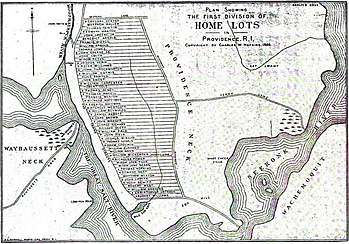
In 1635, Roger Williams — a controversial Puritan preacher in Salem — was banished from Massachusetts Bay Colony[26] and in 1636 he purchased land from the chief sachems of the Narragansetts, Canonicus and Miantonomi, to create Providence Plantation.[27] In 1637, Robert Coles moved from Salem to Providence and the following year he became one of Providence's first 13 proprietors and a founding member of the first Baptist church congregation in America.[28][29] At the inaugural church meeting, at least twelve settlers gathered together with Roger Williams who was "emboldened" by religious dissident Katherine Marbury Scott to make an "open profession." Ezekiel Holliman then baptized Williams who in turn baptized Robert Coles and the others.[30]
Each of the original proprietors received a narrow, six-acre, river-front home lot that stretched eastward from Towne Street, now Main Street, to "a highway," now Hope Street in present-day College Hill, Providence, and they received shares of upland and meadow south of town.[31][32] Robert Coles’s home lot and home[lower-alpha 2] laid between the lots of Thomas Olney and William Carpenter on an ancient "highway" called the Wampanoag trail, now Meeting Street, and his land south of town was east of Mashapaug Pond.[34][35][36] In 1638, Coles moved south to the Pawtuxet River where he built a home[lower-alpha 3] on a six-acre lot near the falls in present-day Pawtuxet Village.[38][39][40] Coles's property south of the Pawtuxet River included a mill, land at Passeonkquis Cove and Namquid now called Gaspee Point, and a large meadow called Ouchamanunkanet.[41][42][43] By 1648 — the year Shawomet was renamed to honor the Earl of Warwick — he was listed among Warwick's townsmen.[44][45]
Plantation Agreement of 1640
— Plantation Agreement at Providence of 1640[46]
In 1640, Robert Coles, Chad Brown, William Harris, and John Warner co-authored the "Report of Arbitrators at Providence, containing proposals for a form of Government," which is also known as the Plantation Agreement at Providence of 1640 and, simply, the Combination. It was ratified by 39 male and female townsmen.[47] The agreement is listed among the colonial documents that influenced American constitutionalism.[48]
The agreement replaced the direct democracy of the original compact of 1637 with a representative, democratic government designed to solve disputes, especially land disputes.[49] It contained 12 articles that defined the borders of Providence, created an arbitral tribunal and an appeals process, created town offices, and affirmed the separation of church and state as the determination "to hold forth liberty of conscience." The agreement resolved the problem of assembling a quorum of busy townsmen to make decisions, but it left open how those decisions would be enforced.[50][51]
Gorton controversy
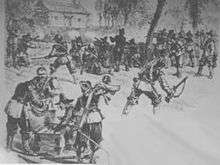
In 1641, Coles and John Greene gave Samuel Gorton — a religious leader and agitator fleeing Portsmouth — some of their land in Pawtuxet.[52][53] The parcel Coles gave to Gorton was at Papaquinapaug, the region near present-day Fenner Pond south of Roger Williams Park.[54][55] To Coles's dismay, Gorton and his followers, the Gortonites, rejected the authority of the Plantation Agreement of 1640 and became embroiled in bitter disputes.[56] The trouble began when the Providence arbitrators voted to settle a dispute by seizing some cattle owned by a Gortonite named Francis Weston. The Gortonites fought off the townsmen sent to take the cattle.[57] Seeking a way to expel the Gortonites from Pawtuxet, Coles and three other original Pawtuxet settlers — William Arnold, William Carpenter, and Benedict Arnold — traveled to Boston in 1642 to petition the General Court to place their land under the jurisdiction of Massachusetts Bay Colony.[58] The General Court made Coles and the other three petitioners justices of the peace.[59] The Gortonites moved south to Shawomet, out of the jurisdiction of the justices and Massachusetts Bay, where they purchased 90 square miles from the sachem Miantonomi.[60] Benedict Arnold convinced the sachems of Pawtuxet and Shawomet — Socononoco and Pomham — to complain to Massachusetts Bay that they did not agree to the sale.[61] In 1643, Gorton and some Gortonites were arrested by Massachusetts Bay soldiers after a violent struggle and taken to Boston to stand trial.[58][62]
Life and family
Robert Coles was born c. 1600 probably in England and died in 1655 in Warwick, Providence Plantations.[63][64]
Coles was said to suffer from "vnsetlednesse & removing frō place to place."[21] Despite — or because of — his unsettledness, he became a successful farmer who was granted and purchased hundreds of acres of land in Massachusetts Bay and the Providence Plantations. In 1650, of the 50 tax-payers in Providence, Benedict Arnold paid the highest property tax while five townsmen — Coles, William Arnold, Richard Scott, William Field, and William Carpenter — paid the second highest tax.[65] At his death, Coles left about £500 to his heirs, which was a large estate at that time.[44]
His religious life, too, was changeful. He was excommunicated by his Puritan church in Massachusetts Bay, which may have contributed to his moving to Providence.[66][63] In Providence, he was a founding member of the Baptist church, but it was later said that, in lieu of Christian worship, he "usually conversed with and was conversant amongst the Indians on the Sabbath days" to learn about Native American religion.[67][lower-alpha 4]
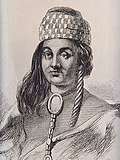
Coles occasionally fell out with his indigenous neighbors. In 1649, two Narragansetts — Nanheggen of Pawtuxet and Wesuontup of Mashapaug — were accused of breaking into the Providence homes of Coles and Jane Sears. Nanheggen, who was one of Coles's workers, was convicted by a jury while Wesuontup was acquitted.[68] In 1652, Coles sold a mastiff dog to Ninigret, the sachem of the Niantic people. The dog ran away from Ninigret and returned to Coles who killed it. Coles was fined after Ninigret pressed charges.[69][70]
Coles was married twice. He and his first wife, Mary, appeared together for the first time in the records of the Roxbury church.[4][lower-alpha 5] His second wife, Mary Hawxhurst (c. 1602–1656), was the daughter of Sampson Hawxhurst (1571–1627), vicar of Nuneaton in Warwickshire, England, and Elizabeth.[72][71][lower-alpha 6] After Robert Coles's death, Mary Hawxhurst married Matthias Harvey and moved to Oyster Bay on Long Island.[43]
Robert Coles had at least seven children, four of whom were under 18 years of age when he died. His children by his first wife, Mary, were John Coles (m. Ann), Deliverance Coles (m. Richard Townsend), and Ann Coles (m. Henry Townsend). His children by his second wife, Mary Hawxhurst, were Daniel Coles (m. Mahershalalhasbaz Gorton, daughter of Samuel Gorton), Nathaniel Coles (m. Martha Jackson, Deborah Wright, Sarah Harcurt), Sarah Coles (m. Captain Thomas Townsend), and Captain Robert Coles Jr. (m. Mercy Wright).[73][19]
Three of Coles's daughters married into the Townsend family. The Townsends came to Warwick after conflicts over religious liberty with authorities in the Dutch colony of New Netherland. Henry Townsend, who married Ann Coles, was fined and imprisoned more than once in New Netherland for hosting Quaker meetings and political agitation.[lower-alpha 7] The Townsends later settled in Oyster Bay, which was out of Dutch jurisdiction.[74][lower-alpha 8]
Three of Coles's sons — Robert Jr., Nathaniel, and Daniel Coles — were original proprietors of Musketa Cove Plantation, now the town of Glen Cove, New York, near Oyster Bay.[75] The home that Robert Coles Jr. built in 1668 in Musketa Cove still stands.[76]
Notable descendants
The descendants of Robert Coles include industrialist Walter Chrysler (1875–1940) who founded the Chrysler Corporation,[77] actors Tom Selleck (1945-)[78] and Richard Jordan (1937–1993),[77] novelist Miriam Coles Harris (1834–1925),[79] American Revolutionary War spies Robert Townsend (1753–1838) and Sarah (Sally) Townsend (1760–1842) who where siblings and members of the secret Culper Ring,[80] and spy Jesse Coles (1757–1839) who was captured while carrying a message to General Washington.[81]
Notes
- ↑ From the Roxbury church records: "Mary Cole, the wife of Robert Cole. God also wrought vpon her heart (as it was hoped after her coming to NE but after her husband's excommunication, & falls she did too much favor his ways, yet not as to incur any just blame, she lived an aflicted life, by reason of his vnsetlednesse & removing fro place to place."[21]
- ↑ In 1653, Coles sold his Providence home lot and home to Richard and Mary Pray.[33]
- ↑ In 1654, Coles sold his Pawtuxet home to Zachariah Rhodes.[37]
- ↑ According to Samuel Gorton, "...Robert Cole whom they had censured to weare a D on his back for a whole year, to proclaim unto all men his guiltiness of the sin of drunkenness and had also cast him out of their Church, and delivered him unto Satan several times, who before, and in the time of this his submission usually conversed with, and was conversant amongst the Indians on the Sabbath days, professing the Indians' religion to be the same with that which the Massachusetts professed and practised."[66]
- ↑ Because Mary's undated death was noted in Roxbury church records, it is thought Mary died before Coles moved to Providence.[71]
- ↑ Robert Coles's first son, John, refers to Mary Hawxhurst as his "mother-in-law" in 1655, confirming she was his stepmother.[63]
- ↑ Henry Townsend signed the Flushing Remonstrance in 1657 which protested the persecution of Quakers and others in New Netherland.[74]
- ↑ Deliverance Coles, Richard Townsend's first wife, possibly died in Warwick.[43]
References
Citations
- ↑ Stewart 2015.
- 1 2 Anderson 1995, p. 436.
- ↑ Ellis 1847, p. 15.
- 1 2 Thwing 1908, p. 45.
- ↑ Drake 1878, p. 290.
- ↑ Cole 1887, p. 89.
- ↑ Shurtleff 1853, p. 95.
- ↑ Hammatt 1854, p. 62.
- ↑ Waters 1905, pp. 15,60.
- 1 2 Macdonough 1901, p. 444.
- ↑ Upham 1867, pp. 88,85,XXV.
- ↑ Noble 1904, p. 18.
- ↑ Adams 1896, p. 356.
- ↑ Adams 1896, p. 355.
- ↑ Wilson & Fiske 1888, p. 167.
- ↑ Noble 1904, p. 21.
- ↑ Noble 1904, p. 34-35.
- ↑ Noble 1904, p. 41.
- 1 2 3 Anderson 1995, p. 438.
- ↑ Salinger 2004, p. 111.
- 1 2 3 Boston Registry Department 1884, p. 75.
- ↑ Seton 1958, p. 243.
- ↑ Beers 1895, p. 24.
- ↑ Orians 1952, p. 429.
- ↑ Pennell & Hawthorne 2018, p. 31.
- ↑ Warren 2018, p. 54.
- ↑ Warren 2018, p. 63.
- ↑ Macdonough 1901, pp. 445-446.
- ↑ King & Wilcox 1908, p. 187.
- ↑ Winthrop & Hosmer 1966, p. 297.
- ↑ Macdonough 1901, p. 446.
- ↑ Hopkins 1886, p. 27.
- ↑ Rogers 1892, pp. 13.
- ↑ Rogers 1899, p. 31.
- ↑ Hopkins 1886, pp. 65,13.
- ↑ Greene 1890, p. 280.
- ↑ Cock & Cox 1914, p. 361.
- ↑ Rogers 1899, p. 99.
- ↑ Field 1902, p. 32.
- ↑ Hopkins 1886, p. 67.
- ↑ Reibold 1998, pp. 13-14.
- ↑ Chapin 1926, pp. 138,227,262,278.
- 1 2 3 Cocks & Cox 1914, p. 362.
- 1 2 Macdonough 1901, p. 454.
- ↑ Conley 2010, p. 46.
- ↑ Rhode Island & Bartlett 1856, pp. 27.
- ↑ Rhode Island & Bartlett 1856, pp. 27-31.
- ↑ Lutz 1998, p. 36.
- ↑ Keary 1996, p. 273.
- ↑ Field 1902, p. 34.
- ↑ Bayles 1891, pp. 148-151.
- ↑ Field 1902, p. 61.
- ↑ Chapin 1916, p. 144.
- ↑ Gorton 1907, p. 38.
- ↑ Chapin 1916, p. 145.
- ↑ McLoughlin 1976, p. 17.
- ↑ D'Amato 2001, p. 23.
- 1 2 Field 1902, p. 62.
- ↑ Tompkins 1919, p. 3.
- ↑ Tompkins 1919, p. 3-4.
- ↑ D'Amato 2001, p. 24.
- ↑ Tompkins 1919, p. 5.
- 1 2 3 Anderson 1995, p. 437.
- ↑ Stiles 1901, p. 174.
- ↑ Rogers 1899, p. 33.
- 1 2 Macdonough 1901, p. 447.
- ↑ Cocks & Cox 1914, p. 361.
- ↑ Rogers 1899, pp. 24-25.
- ↑ Macdonough 1901, pp. 451,453,454.
- ↑ Fisher & Silverman 2014, p. 77.
- 1 2 Anderson 1995, p. 439.
- ↑ Stiles 1900, p. 174.
- ↑ Cocks & Cox 1914, p. 364.
- 1 2 Townsend 1909, p. 68.
- ↑ Petrash 2005.
- ↑ Russell.
- 1 2 BYU.
- ↑ Hall.
- ↑ Faust 1983, pp. 301-303.
- ↑ Misencik 2016, pp. 6,194.
- ↑ Carpenter 1901, pp. 170-171.
Bibliography
Books
- Adams, Charles Francis (1896). Three episodes of Massachusetts history: the settlement of Boston Bay, the Antinomian controversy, a study of church and town government. Boston; New York: Houghton, Mifflin and Co.

- Anderson, Robert Charles (1995). The Great Migration Begins Vol. 1. New England Historic Genealogical Society.
- Bayles, Richard M. (1891). History of Providence County, Rhode Island. New York: W.W. Preston.
- Beers, Henry Augustin (1895). Studies in American Letters. G.W. Jacobs.
- Boston Registry Department (1884). Records relating to the early history of Boston. 6. Boston: Boston, Rockwell and Churchill, City Printers.
- Carpenter, Daniel Hoogland (1901). History and genealogy of the Carpenter family in America, from the settlement at Providence, R.I., 1637-1901. Jamaica, NY: Marion Press.
- Chapin, Howard M. (1916). Documentary History of Rhode Island. Providence: Preston and Rounds Company.

- Chapin, Howard M. (1926). The early records of the town of Warwick. Providence: E.A. Johnson.
- Cocks, George Williams; Cox, John (1914). History and Genealogy of the Cock, Cocks, Cox Family: Descended from James and Sarah Cock, of Killingworth Upon Matinecock, in the Township of Oyster Bay, Long Island, N.Y.

- Cole, Frank Theodore (1887). The Early Genealogies of the Cole Families in America: (Including Coles and Cowles). With Some Account of the Descendants of James, by Hartford, Connecticut, 1635-1652, and of Thomas Cole, of Salem, Mass., 1649-1672. Columbus: Hann & Adair.
- Conley, Patrick T. (2010). Rhode Island's founders: from settlement to statehood. Charleston, SC: History Press.
- D'Amato, Donald A. (2001). Warwick: A City at the Crossroads. Charleston, SC: Arcadia Publishing.
- Drake, Francis S. (1878). The town of Roxbury: its memorable persons and places, its history and antiquities, with numerous illustrations of its old landmarks and noted personages. Roxbury.
- Earle, Alice Morse (1922). Curious Punishments of Bygone Days. Macmillan.

- Ellis, Charles Mayo (1847). The History of Roxbury Town. Boston: Samuel G. Drake.
- Faust, Langdon L. (1983). American women writers: a critical reference guide from colonial times to the present. New York: Unger.
- Field, Edward (1902). State of Rhode Island and Providence Plantations at the End of the Century. Rhode Island: Mason Publishing Company.
- Fisher, Julie A.; Silverman, David J. (2014). Ninigret, sachem of the Niantics and Narragansetts: diplomacy, war, and the balance of power in seventeenth-century New England and Indian country. Ithaca: Cornell University Press.
- Fuller, Oliver Payson (1875). The History of Warwick, Rhode Island, from Its Settlement in 1642 to the Present Time. Warwick, RI: Angell, Burlingame & Company.
- Gorton, Adelos (1907). The life and times of Samuel Gorton. Philadelphia: Higginson Book Company.
- Hammatt, Abraham (1880). The Hammatt Papers No. 1: Early inhabitants of Ipswich, Mass. 1633-1700. Ipswich, Mass.: Antiquarian Papers Press.
- Hopkins, Charles Wyman (1886). The home lots of the early settlers of the Providence Plantations : with notes and plats. Providence: Providence Press.
- King, Henry Melville; Wilcox, Charles Field (1908). Historical catalogue of the members of the First Baptist Church in Providence, Rhode Island. F.H. Townsend, Printer.
- Lutz, Donald S. (1998). Colonial origins of the American Constitution: a documentary history. Indianapolis: Liberty Fund.
- Macdonough, Rodney (1901). The Macdonough-Hackstaff ancestry. Boston: Samuel Usher.
- Massachusetts Historical Society (1885). Proceedings of the Massachusetts Historical Society. 2. 1. Cambridge: Massachusetts Historical Society.
- McLoughlin, William G. (1976). Rhode Island: A History. New York, New York: W. W. Norton & Company.
- Misencik, Paul R. (2016). Sally Townsend, George Washington's teenage spy. Jefferson, North Carolina: McFarland & Company, Inc.
- Noble, John (1904). Records of the Court of Assistants of the colony of the Massachusetts Bay, 1630-1692. 2. Boston: Suffolk County.

- Pennell, Melissa McFarland; Hawthorne, Nathaniel (2018). The historian's Scarlet letter: reading Nathaniel Hawthorne's masterpiece as social and cultural history. Santa Barbara: Praeger.
- Reibold, Dorothy Marty (1998). The life of Matthias Harvye and family. Baltimore, MD: Gateway Press, Inc.
- Rhode Island; Bartlett, John Russell (1856). Records of the colony of Rhode Island and Providence Plantations, in New England: Printed by order of the General Assembly. 1. Providence: A.C. Greene and Brother.
- Rogers, Horatio (1892). The Early Records of the Town of Providence. II. Providence, RI: Snow & Farnham.
- Rogers, Horatio (1899). The Early Records of the Town of Providence. XV. Providence, RI: Snow & Farnham.
- Salinger, Sharon V. (1858). Taverns and Drinking in Early America. Boston: Johns Hopkins University Press.
- Seton, Anya (1958). The Winthrop Woman. New York: Houghton Mifflin Harcourt.
- Shurtleff, Nathaniel B. (1853). Records of the Governor and Company of the Massachusetts Bay in New England. 1. Boston: W. White.
- Stiles, Henry R. (1900). The New York Genealogical and Biographical Record. 32. New York: New York Genealogical and Biographical Society.
- Thwing, Walter Eliot (1908). History of the First Church in Roxbury, Massachusetts, 1630-1904. Boston: W.A. Butterfield.
- Townsend, Margaret (1909). Townsend--Townshend, 1066-1909: the history, genealogy and alliances of the English and American house of Townsend. New York: Press of the Broadway.
- Upham, Charles Wentworth (1867). Salem witchcraft: with an account of Salem village, and a history of opinions on witchcraft and kindred subjects. Boston: Wiggin and Lunt.
- Warren, James A. (2018). God, War, and Providence: The Epic Struggle of Roger Williams and the Narragansett Indians against the Puritans of New England. New York, New York: Simon and Schuster.
- Waters, Thomas Franklin (1905). Ipswich in the Massachusetts Bay Colony. Ipswich, MA: The Ipswich historical society.
- Wilson, James Grant; Fiske, John (1888). Appleton's Cyclopædia of American Biography. 4. D. Appleton.

- Winthrop, John; Hosmer, James K. (1966). Winthrop's Journal, "History of New England," 1630-1649. 1. New York: Barnes & Noble.
Articles
- Greene, Welcome A. (1890). "The History of a Ferry". The Narragansett Historical Register: A Magazine Devoted to the Antiquities, Genealogy and Historical Matter Illustrating the History of the State of Rhode Island and Providence Plantations. Narragansett Historical Publishing Company. 8: 274–301.
- Keary, Anne (1996). "Retelling the History of the Settlement of Providence: Speech, Writing, and Cultural Interaction on Narragansett Bay". The New England Quarterly. 69 (2): 250–286.
- Orians, G. Harrison (1952). "Hawthorne and Puritan Punishments". College English. 13 (8): 424–432.
- Tompkins, Hamilton Bullock (October 1919). "Benedict Arnold, First Governor of Rhode Island (A paper read before the Newport Historical Society)". Bulletin of the Newport Historical Society. 30: 1–18.
Online sources
- BYU. "Exploring Relatives for Robert Coles". www.relativefinder.org. Retrieved 15 September 2018.
- Hall, Rich. "Family relationship of Robert Coles and Tom Selleck via Robert Coles". famouskin.com. Retrieved 15 September 2018.
- Petrash, Antonia; Stern, Carol; McCrossen, Carol (2005). "History of Glen Cove". Glen Cove Public Library. Retrieved 7 July 2018.
- Russell, Daniel E. "The Robert Coles Homestead (1668)" (PDF). City of Glen Cove, New York. Retrieved 14 August 2018.
- Stewart, Marcia (2005). "The Freemen of Massachusetts Bay 1630 - 1636". The Winthrop Society. Retrieved 7 July 2018.
External links
- Coles's home lot in Agawam (Ipswich), Google map
- Coles's farmland (plot XXIV) in Salem, Google map
- Coles's home lot (#20) in the town of Providence, Google map
- Full text of Plantation Agreement at Providence of 1640

